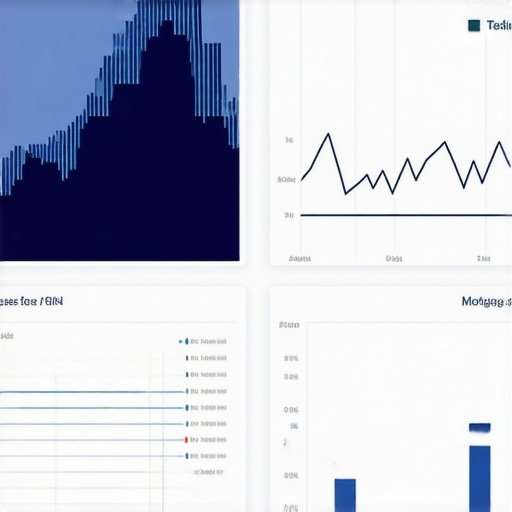My Journey into the World of Tennessee Mortgage Options
Last year, as I started exploring buying my first home in Tennessee, I realized how overwhelming the mortgage landscape could be. With countless lenders and loan types, I knew I needed a clear strategy to compare my options effectively. Sharing this personal experience, I hope to shed some light on the best ways to navigate Tennessee’s mortgage market in 2025.
Understanding the Different Types of Mortgages in Tennessee
When I first looked into mortgages, I was surprised by the variety available, including fixed-rate, adjustable-rate, VA, FHA, and USDA loans. Each has its advantages depending on your financial situation. For example, I found that loan types significantly influence your mortgage costs, so I took the time to analyze which fits my budget best.
How I Narrowed Down My Options Using Personal Criteria
To compare mortgage options, I started by assessing my credit score, down payment capacity, and long-term financial goals. I learned that a higher credit score could secure me better interest rates, as explained in how credit scores impact interest rates. This insight helped me prioritize lenders offering competitive rates for my profile.
Creative Strategies for Comparing Tennessee Mortgage Rates
I used several tactics to compare rates effectively. First, I checked daily mortgage rate updates, which allowed me to spot trends and time my application for lower rates. Additionally, I leveraged online calculators and contacted multiple lenders for personalized quotes. For detailed rate comparisons, I found top tips for shopping for mortgage rates in Tennessee invaluable.
Is Locking in the Rate the Best Move?
How do I decide the right moment to lock in my mortgage rate in Tennessee?
This was a critical question I wrestled with. I learned that timing is essential because mortgage rates fluctuate frequently, and locking in at the right time can save thousands. According to market trend predictions, monitoring daily updates and consulting with a trusted mortgage broker could help determine the optimal locking point.
If you’re curious about the latest Tennessee mortgage market trends, I recommend exploring resources like the inside Tennessee FHA loan rates page for current insights.
If you’re in the process of comparing options, I encourage you to share your experiences or ask questions in the comments below. Your journey might just help someone else find the perfect mortgage plan in Tennessee!
Unlocking the Secrets of Tennessee’s Mortgage Market: Expert Tips for 2025
As an industry insider, I’ve seen firsthand how Tennessee’s mortgage landscape is evolving. Whether you’re a first-time homebuyer or an investor, understanding the nuanced trends can make all the difference. One key area to focus on is the timing of rate locks. Many experts agree that strategic locking can save thousands, especially amid fluctuating market conditions. For instance, monitoring daily updates on daily mortgage rate trends empowers buyers to act at the optimal moment.
What Factors Should Influence Your Decision to Lock or Float Your Rate?
Several factors come into play when deciding whether to lock in your mortgage rate. These include current market volatility, economic indicators, and your personal financial timeline. As I’ve observed, lenders often provide rate lock options ranging from 30 to 60 days, giving buyers flexibility. According to data from Tennessee FHA loan rate insights, understanding regional trends can also inform your decision. For example, Memphis has seen a slight uptick in fixed rates, prompting some buyers to lock early to avoid future increases.
Additionally, consulting with local experts or mortgage brokers—who have their finger on the pulse of Tennessee’s economic conditions—can provide personalized guidance. This approach aligns with the advice from leading sources on refinance rate locking strategies.

Incorporating these insights, I recommend setting up alerts for daily rate changes and maintaining open communication with your lender to stay ahead of market shifts.
How Can You Leverage Tennessee-Specific Market Data to Maximize Savings?
Understanding local market dynamics is crucial. Tennessee’s housing market, notably in cities like Nashville and Memphis, has unique trends that influence mortgage rates. For example, recent market trend reports reveal that rate fluctuations often correspond with regional employment data and economic growth indicators.
By analyzing such data, savvy buyers can identify windows of opportunity. For instance, if employment figures suggest a downturn, lenders might reduce rates to attract borrowers, creating an advantageous environment for locking in a loan. Conversely, understanding when the market is heating up helps you avoid locking in at higher rates. This strategic approach is detailed in the comprehensive guide on market analysis techniques.
To deepen your knowledge, I suggest exploring the latest Tennessee mortgage rate forecasts and comparing them with historical data. This proactive stance ensures you’re not just reacting to market changes but anticipating them.
What Practical Steps Can You Take Today to Prepare for 2025’s Mortgage Opportunities?
Preparation begins well before your application. Improving your credit score by paying down debt, avoiding new loans, and verifying your financial documents can position you for better rates. Additionally, consulting reputable resources like top shopping tips can help you identify lenders offering competitive terms.
Remember, locking in a rate is often a strategic move tied to your home purchase timeline. If you’re considering refinancing or buying soon, stay informed about current trends through trusted sources. For example, following FHA loan rate updates provides timely insights that can influence your decision-making process.
I encourage you to share your experiences, ask questions, or suggest more reading on our site. Your insights could help others navigate Tennessee’s mortgage market with confidence.
Deepening My Understanding of Tennessee’s Mortgage Nuances
As I delved further into Tennessee’s mortgage landscape, I realized that the regional economic factors play a crucial role in shaping mortgage rates. For instance, the employment trends in Nashville often influence lender appetite and rate offerings, creating opportunities for savvy buyers to lock in favorable terms. This understanding prompted me to stay vigilant with local market reports, like those found on market trend reports, which provide insights beyond national averages.
Reflecting on My Rate Lock Decision: A Personal Evolution
Initially, I hesitated about locking my mortgage rate due to the volatility I observed. However, after consulting with a local broker and analyzing daily rate updates via rate trend tools, I decided to lock in my rate just before a slight uptick. This experience underscored the importance of timing and regional insights, which can significantly impact the financial outcome of your home purchase or refinance.
What Are the Hidden Factors That Could Influence Your Mortgage Strategy?
Beyond the obvious elements like credit scores and loan types, I discovered that regional housing inventory levels and seasonal market fluctuations could subtly influence mortgage rates. For example, during peak home-buying seasons, increased competition among lenders might lead to better rates or more flexible terms. Conversely, in slower months, lenders might tighten their offerings, making it prudent to lock in rates earlier. Learning this, I keep an eye on regional market analytics to refine my approach.
How Can You Harness Local Data and Personal Timing to Maximize Savings?
In my journey, I found that integrating local economic indicators with personal financial preparedness is key. For instance, if employment numbers are rising in Memphis, lenders might anticipate higher rates, prompting me to consider locking sooner. To stay ahead, I set alerts on FHA rate updates and keep regular communication with my lender. This proactive stance gave me confidence and a sense of control over my mortgage decisions.
Inviting Your Personal Experiences and Questions
Have you navigated Tennessee’s mortgage market recently? What strategies worked for you, or what uncertainties did you face? Sharing your story could illuminate new perspectives for others in our community. Feel free to comment below or explore more on our contact page. Remember, understanding the nuanced landscape of Tennessee’s mortgage options is an ongoing journey—one that benefits from shared insights and continuous learning.
Deciphering the Regional Economic Indicators That Influence Your Mortgage Rates in Tennessee
During my deep dive into Tennessee’s mortgage landscape, I uncovered that local economic indicators—such as employment rates, industrial growth, and housing inventory levels—serve as subtle yet powerful drivers of mortgage interest rates. For instance, in Nashville, a surge in the tech sector often correlates with increased mortgage applications, which can temporarily tighten lending criteria and influence rate fluctuations. Conversely, a slowdown in housing supply during off-peak seasons may prompt lenders to offer more competitive rates to attract borrowers. Staying abreast of data from sources like the Tennessee housing market reports has been instrumental in helping me time my rate lock optimally.
How I Leveraged Advanced Market Analytics to Optimize My Mortgage Strategy
Beyond basic market observations, I incorporated sophisticated analytics tools—such as predictive modeling and trend analysis—to forecast potential rate movements. By analyzing historical data and current economic signals, I identified patterns that suggested imminent rate hikes or dips. For example, I noticed that a spike in regional unemployment often precedes a decline in mortgage rates, providing a strategic window for locking in a favorable rate. This approach aligns with expert methodologies outlined in the comprehensive guide on market trend analysis. Utilizing these insights, I set dynamic alerts and maintained close communication with my lender, ensuring I acted decisively at the right moment.

Visualizing regional economic data through customized dashboards enhanced my decision-making process, giving me a clear picture of when to lock or float my mortgage rate.
What Are the Critical Considerations When Locking in a Rate During Market Volatility?
Timing a rate lock amidst market volatility requires a nuanced understanding of both macroeconomic trends and regional activity. I found that economic indicators like Federal Reserve policy shifts and inflation reports significantly impact mortgage rate stability. Consulting authoritative sources such as the Tennessee FHA loan rate trends provided me with timely updates. Additionally, I evaluated my personal financial timeline—whether I was ready to proceed with my purchase or refinance—to determine the optimal lock period. A longer lock can safeguard against rising rates but may come with higher fees, so balancing risk and cost was crucial in my decision-making process.
If you’re navigating similar choices, I recommend exploring advanced strategies like hybrid lock options and monitoring regional economic reports regularly to capitalize on favorable market conditions.
Things I Wish I Knew Earlier (or You Might Find Surprising)
The Hidden Impact of Local Economic Trends
One thing I underestimated was how regional economic indicators, like employment rates and housing inventory, could subtly influence mortgage rates. When I noticed Nashville’s tech boom, I realized it affected lender behavior and rate fluctuations more than I expected. Keeping an eye on local market reports helped me time my rate lock better.
The Power of Daily Rate Monitoring
At first, I thought waiting for official rate announcements was enough, but I learned that checking daily mortgage rate updates gave me a competitive edge. Small dips and spikes could save or cost thousands, so I set up alerts and stayed vigilant, which made a big difference in my overall savings.
The Importance of Regional Data
Understanding Tennessee-specific market data, like Memphis’s housing trends, helped me decide when to lock my rate. I found that regional reports provided insights beyond national averages, highlighting opportunities to lock in lower rates during certain periods.
Timing Your Rate Lock
Initially, I hesitated to lock my rate due to market volatility, but after consulting with a local broker and analyzing trend tools, I realized that strategic timing—like locking just before a rate uptick—could save thousands. It taught me that patience and regional insights are essential.
Balancing Market Data With Personal Readiness
While market trends are crucial, I also learned to assess my personal financial situation. Improving my credit score and preparing documents early allowed me to act swiftly when the right opportunity arose, blending personal readiness with market timing.

